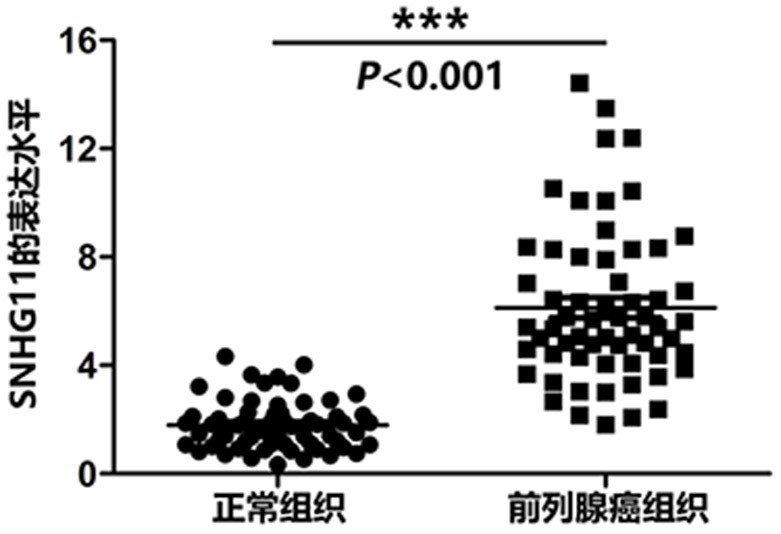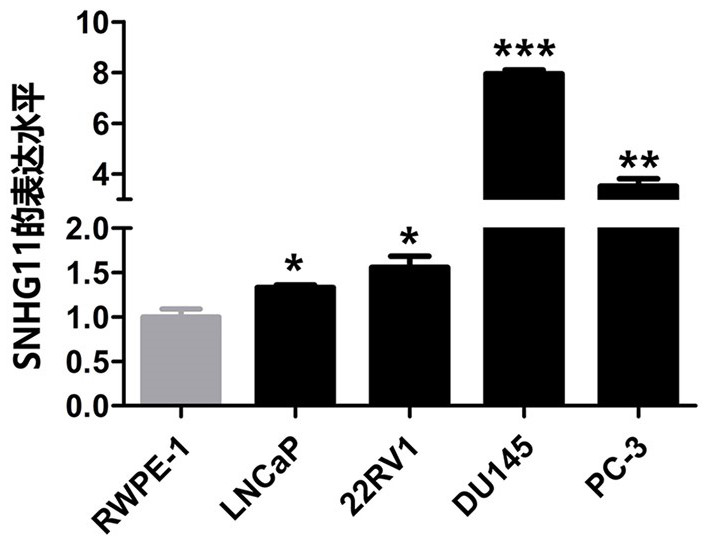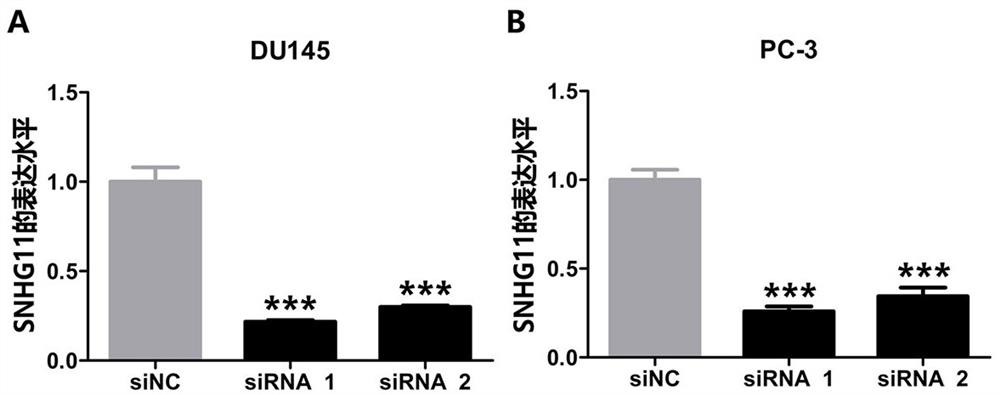Marker and kit for auxiliary diagnosis of prostatic cancer
A technology for prostate cancer and auxiliary diagnosis, which is applied in the field of medicine and biology, can solve the problems of lack of specific diagnostic indicators, etc., and achieve the effects of inhibiting growth, inhibiting proliferation, and promoting proliferation
- Summary
- Abstract
- Description
- Claims
- Application Information
AI Technical Summary
Problems solved by technology
Method used
Image
Examples
Embodiment 1
[0061] Example 1: Study on the Expression of LncRNA SNHG11 in Prostate Cancer Tissues and Their Matched Paracancerous Normal Tissues
[0062] 1. Sample collection:
[0063] Collect 60 cases of histopathologically confirmed primary prostate cancer cancer tissue and corresponding adjacent normal tissue samples > 3cm. In order to prevent the degradation of RNA, the specimens were cut immediately after surgical resection, and washed twice with PBS. Put it into a cryopreservation tube and put it into liquid nitrogen immediately, and finally transfer it to a -80°C refrigerator for long-term storage. None of the 60 prostate cancer patients received radiotherapy and chemotherapy before surgery, and surgery was the preferred treatment option. According to the system stipulated by the ethics review committee, each patient signed an informed consent form before sampling.
[0064] 2. Experimental method
[0065] qRT-PCR was used to detect the expression level of LncRNA SNHG11 in the ca...
Embodiment 2
[0107] Example 2: Study on the expression of LncRNA SNHG11 in prostate cancer cells and normal prostate cell lines
[0108] 1. Cell selection and culture:
[0109] Human normal prostate cell line RWPE-1, prostate cancer cell lines LNCaP, 22RV1, DU145, PC-3 were cultured; the cells were routinely cultured in 1640 cell culture medium containing 10% FBS, 1% penicillin and streptomycin, in which RWPE-1 uses KM medium, PC-3 uses F-12K medium instead of 1640 medium, and the five kinds of cells are stored at 37°C and 5% CO 2 and cultured under conditions of saturated humidity. The cells were replaced every 2 days and passaged at a ratio of 1:3.
[0110] 2. Experimental method:
[0111] qRT-PCR was used to detect the expression level of LncRNA SNHG11 in prostate cancer cells and normal prostate cell lines, and the specific steps were as follows:
[0112] (1) Extraction of cellular RNA:
[0113] Total cellular RNA was extracted by TRIzo1 method.
[0114] Collect the cells in the ...
Embodiment 3
[0124] Example 3: Knockout of LncRNA SNHG11 Gene
[0125] 1. Cell culture:
[0126] Human prostate cancer cell lines DU145 and PC-3 were cultured in 1640 cell culture medium and F-12K medium containing 10% fetal bovine serum and 1% penicillin and streptomycin at 37°C and 5% CO respectively. 2 , Cultivated in an incubator with a relative humidity of 90%. The cells were changed every 2 days, and digested and passaged with digestive enzymes.
[0127] 2.siRNA design
[0128] siRNA sequence against LncRNA SNHG11 gene:
[0129] Negative control siRNA (referred to as siNC) sequence:
[0130] The sense strand of siNC is: 5'-UUCUCCGAACGUGUCACGUTT-3';
[0131] The antisense strand of siNC is: 5'-ACGUGACACGUUCGGAGAATT-3'.
[0132] siRNA 1:
[0133] The sense strand of siRNA 1 is: 5'-GCACUAGAGAGAGCGUCUUGU-3' (SEQ ID NO.4);
[0134] The antisense strand of siRNA 1 is: 5'-ACAAGACGCUCUCUCUAGUGC-3' (SEQ ID NO.5).
[0135] siRNA 2:
[0136]The sense strand of siRNA 2 is: 5'-GGCUAUCCU...
PUM
 Login to View More
Login to View More Abstract
Description
Claims
Application Information
 Login to View More
Login to View More - R&D
- Intellectual Property
- Life Sciences
- Materials
- Tech Scout
- Unparalleled Data Quality
- Higher Quality Content
- 60% Fewer Hallucinations
Browse by: Latest US Patents, China's latest patents, Technical Efficacy Thesaurus, Application Domain, Technology Topic, Popular Technical Reports.
© 2025 PatSnap. All rights reserved.Legal|Privacy policy|Modern Slavery Act Transparency Statement|Sitemap|About US| Contact US: help@patsnap.com



